The Sapphire R9 280X Toxic Review
by Ryan Smith on October 10, 2013 8:00 AM EST- Posted in
- GPUs
- Radeon
- Sapphire
- Tahiti
- Radeon 200
Overclocking
Our final evaluation criteria is overclocking. And this will be short and sweet, as the 280X Toxic isn’t really designed for end user overclocking in the first place. Without voltage adjustment and already shipping at clockspeeds towards the tail end of the curve for the Tahiti GPU, there was absolutely no GPU overclocking headroom for our sample. It was rock solid at stock, but even 10MHz more would eventually result in artifacts when validating the overclock.
Every card will be different of course, and we certainly expect some 280X Toxic cards to have some unexploited headroom, but in the case of our card there was none to be found. Sapphire has fully exploited the available headroom of the GPU in their factory overclock.
| Radeon R9 280X Overclocking | |||||
| Sapphire Radeon R9 280X Toxic | XFX Radeon R9 280X DD | Asus Radeon R9 280X DCU II TOP | |||
| Shipping Core Clock | 1100MHz | 850MHz | 970MHz | ||
| Shipping Boost Clock | 1150MHz | 1000MHz | 1070Mhz | ||
| Shipping Memory Clock | 6.4GHz | 6GHz | 6.4GHz | ||
| Shipping Boost Voltage | 1.256v | 1.2v | 1.2v | ||
| Overclock Core Clock | 1100MHz | 880MHz | 1010MHz | ||
| Overclock Boost Clock | 1150MHz | 1030MHz | 1110MHz | ||
| Overclock Memory Clock | 7GHz | 6.6GHz | 6.8GHz | ||
| Overclock Max Boost Voltage | 1.256v | 1.2v | 1.263v | ||
Now the memory overclock on the other hand was more promising. We were able to get our card up to 7GHz, 600MHz (9%) over the shipping memory frequency and a full 1GHz over what the Hynix modules on the card are technically rated for. Of course the 280X already has so much memory bandwidth that the payoff from additional memory bandwidth isn’t quite as great as say a GTX 770, so coupled with the lack of a core overclock the performance gains are miniscule.
While we’re on the subject, it’s worth pointing out that the 280X Toxic has the highest PowerTune limit of any Tahiti card we’ve tested thus far. Unlike every other card, which tops out at +20% (for 300W or so), the Toxic can go to a full +50%, or somewhere north of 375W. For our testing purposes we stuck with 20% for consistency – the additional headroom wouldn’t be of any value in our games as far as we can tell, as opposed to letting FurMark go nuts – but if it were possible to do voltage adjustments on this card, hardcore overclockers would certainly have a lot of headroom for their water/exotic cooled setups.
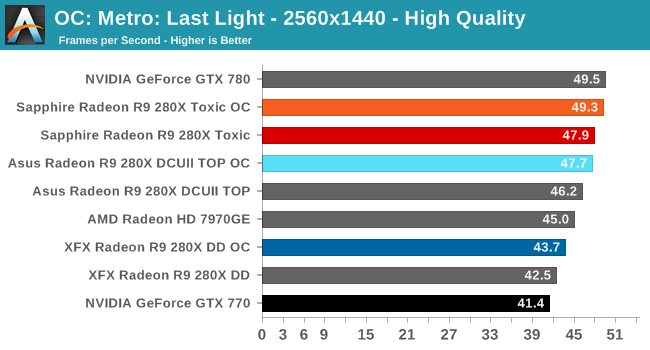
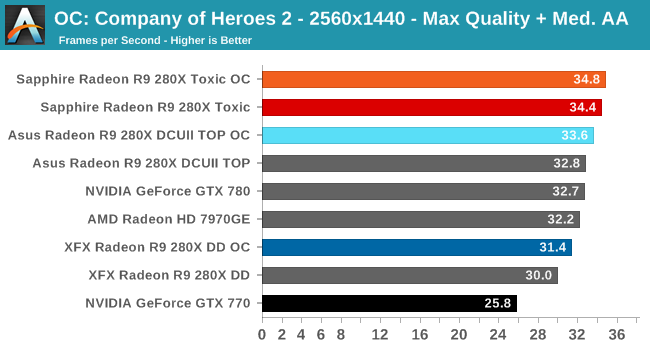
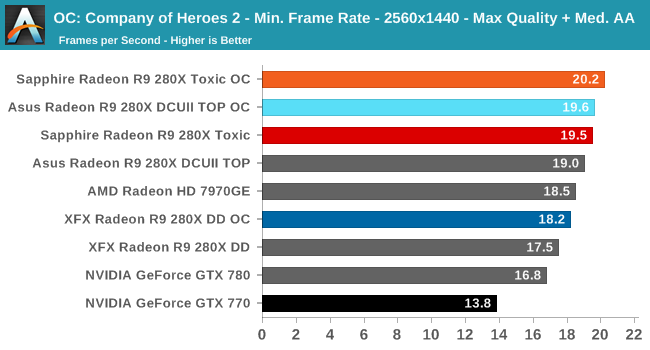
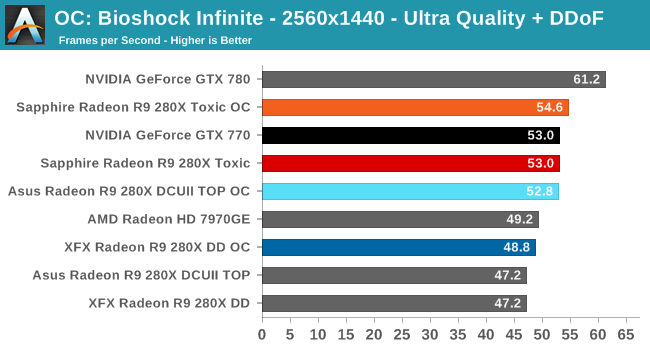
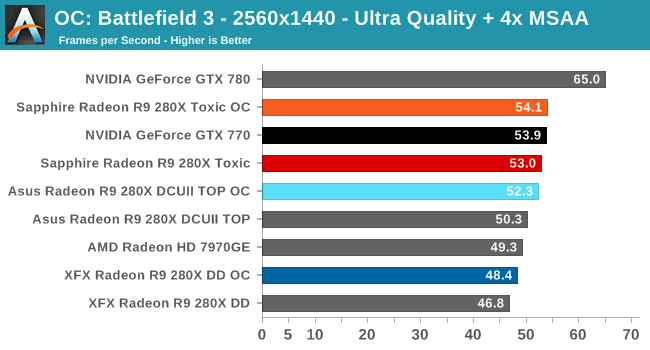

Despite the lack of gains from overclocking, the 280X Toxic is still the fastest 280X card even at stock. Our second best overclocking 280X is the Asus card, which topping out at a boost clock of 1110MHz still falls short of what the Toxic can achieve, and that was after supplying the Asus card with additional voltage. Undoubtedly some 280X cards with voltage adjustment will do better, but our results do paint a very convincing picture for just running the 280X Toxic at stock and ignoring all other cards, with or without overclocking.
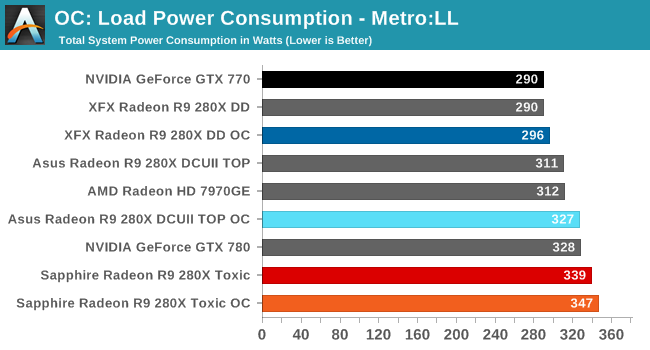
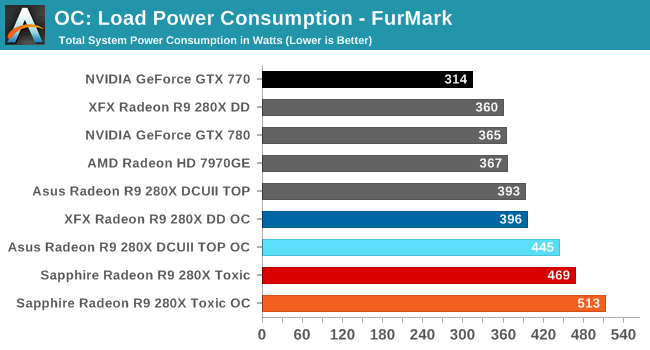
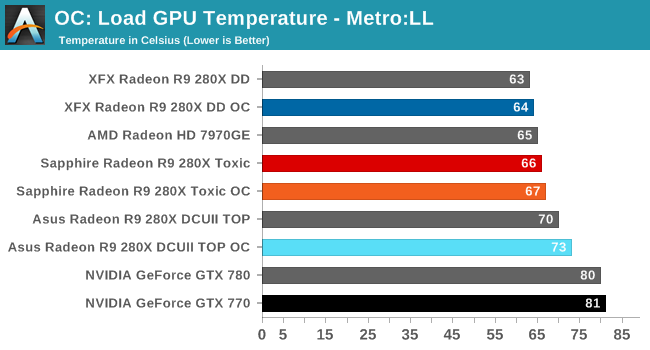

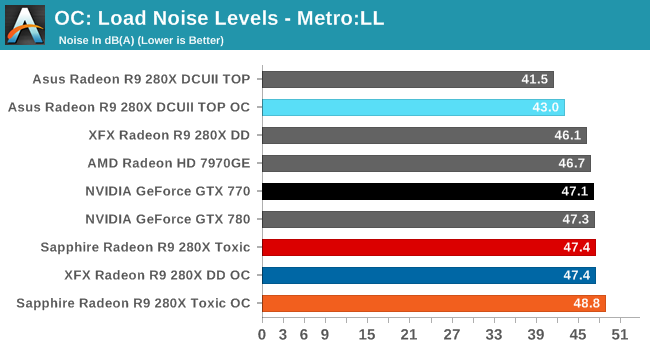
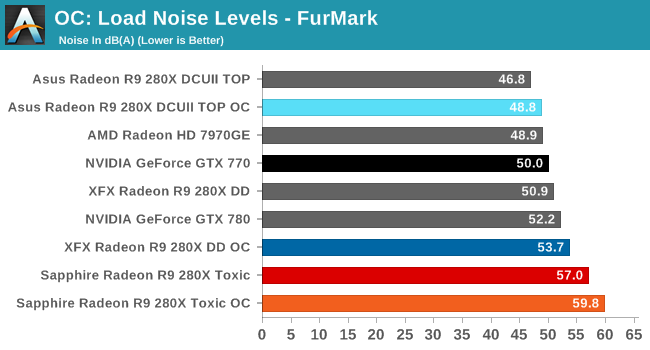
Since we can’t increase the GPU clock or the voltage of the 280X Toxic, the power/temp/noise hit is immaterial under Metro and other gaming workloads. You get almost nothing extra in performance for almost nothing extra in power/temp/noise. With our overclocked results thrown into the mix we can also see that while the stock 280X Toxic outperforms even our overclocked Asus 280X in gaming performance, it also does so while drawing more power than said overclocked Asus card. Clearly nothing is free here; more performance will cause a notable increase in power consumption.
Moving on to FurMark, with that 20% PowerTune increase FurMark absolutely goes nuts. 519W at the wall off of a single card is well out there, and the cooling performance also reflects this. This is all the more reason to leave the 280X Toxic at stock.










84 Comments
View All Comments
ShieTar - Monday, October 14, 2013 - link
Test results depend strongly on the case used for the testing and also on the geometry of the measurement room, most importantly the distance between the card and the microphone.I seem to remember that AT is testing with the card in an open setup, while kitguru are referring to a closed chasis in the review you have linked.
Ryan Smith - Monday, October 14, 2013 - link
For general testing we're in a closed setup, specifically a NZXT Phantom 630 (as listed in our test apparatus section).Also, keep in mind that our intention here is for these results to be relative, not absolute. We're primarily concerned with which card is louder/quieter and by how much. The problem with absolute results is that more so than any other attribute we test, it varies heavily with the environment, both with regards to the case and the room the computer is setup in.
FuriousPop - Thursday, October 10, 2013 - link
hhmmmmm.........not that impressive from the red team and im guessing the 290X will just be a supe'd up 280X (hopefully not). but i think i'll be sticking with my cfx 7970's (asus top versions)... but if the green team drop the 770/780's in price then i do believe those will be a price - performance wise bargin... i guess we must still wait for the 290X to come.....and see...Mombasa69 - Monday, October 14, 2013 - link
"hhmmmmm.........not that impressive from the red team" LMAO! It's near 30% faster than a standard 7970 and is full DX11.2... numb nuts. Even beats a 780 on half the benchmarks and the true Radeon optimized games designed for the new Radeon using consoles aren't even out yet.All this for only £260-£280!
jenesis33 - Thursday, October 10, 2013 - link
NV already stated they are not dropping price for GTX 770 / 780.So yeah. i understand this is not impressive for ppl arleady have 7970 and etc.
But for some1 like me who is upgrading from a GTX 560, i think it's great news.. Awesome performance for price...
FuriousPop - Thursday, October 10, 2013 - link
i disagree - for those in your position i would rather upgrade to a gtx670 or 7850 (or there abouts), save those extra bucks for early next year or better yet, stick with what you got now and purchase something early-mid next year. i only got my 7970's late last year, before that i had a 4870 for as long as i can remember (tried 2xgtx670's but 1 of them DOA, hence 7970 the only choice).prices will always drop - my thoughts have always been whats the best value not what is the best performer out there.... and with this 280X power hunger mode on, i don't see the 290X being any better in that department therefore requiring more out of your whole system to utilize the full performance of it, to which i don't think its worth it....but hey, go nuts if you like!
Yeoman1000 - Friday, October 11, 2013 - link
You can always wait, but you can never really win with tech. In the uk, 7850 is about £110-130. 7970 can be had for £210-230. Bear in mind the 3gb & 384-bit...for peeps in the uk at least it seems like 'old' 7970 stock is the same excellent value as a 7850, for now at least it seems you can't lose.commissar0617 - Saturday, October 12, 2013 - link
WHO CARES ABOUT POWER CONSUMPTION? a 200w power draw difference will mak minimal difference if your power bill....ShieTar - Monday, October 14, 2013 - link
For a serious gamer (1000 hours a year at least), with assumed electricity cost of 0.20$ / kWh, thats already 40$ a year. Keep in mind that people who need to watch that kind of money are often students, some of them playing (and/or working) more than 1000 hours a year, and also keep in mind that some of the international readers of AT may also pay 0.50$/kWh, and you may also be looking at 200$ or more cost per year. Most people won't call that minimal.That aside, I personally do not worry about 60$ electricity per year, but 200W additional draw will lead to a noticeable increase in noise, and that I do care about a lot. So I most definitely care to see those numbers in any review.
Mombasa69 - Monday, October 14, 2013 - link
I'll be upgrading my 3 way 570's for 2 of these Sapphire Radeon R9 280X Toxic's, it even comes with a great oc utility, a small tweak and it'll be as good as the over-priced 780.